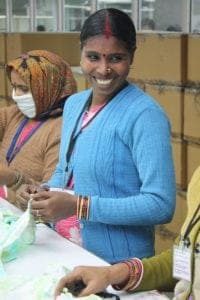
Financial inclusion reform introduced by the Indian government in 2006 led to public sector banks offering a Basic Savings Bank Deposit Account (BSBDA) or “zero balance” accounts in 100,000 villages. Know Your Customer norms were relaxed and the business correspondent model was established to make it easier to bank low-income women. At the end of 2013, nearly 230 million accounts were opened. Huge progress was made towards access to financial services, but the question is… how to increase usage.
What garment employees want
 Our research estimates found there are nearly five million women working in garment factories in India. The factories we visited were paying more than 50 percent of their employees via direct deposit, if not all, presenting an easy opportunity for the unbanked to be introduced to formal financial services. In addition, factory management sees the value in direct deposit: it is less risky than moving cash, there is greater payroll transparency and less fraud, and incur savings in payroll processing.
Our research estimates found there are nearly five million women working in garment factories in India. The factories we visited were paying more than 50 percent of their employees via direct deposit, if not all, presenting an easy opportunity for the unbanked to be introduced to formal financial services. In addition, factory management sees the value in direct deposit: it is less risky than moving cash, there is greater payroll transparency and less fraud, and incur savings in payroll processing.
Both parties agree that the system is something they both like and benefit from: research with the employees showed a desire to have and use an account: “Cash in hand is spent. If I keep cash and someone asks for it, I cannot say no, so it is better not to have cash,” said one woman in Bangalore. “With the ATM, I’m leaving 500 [rupees].” Enthusiasm for the idea however, does not translate into positive financial behavior. While many more women hold bank accounts, the number of transactions is quite small—meaning people are not using their accounts. This is due to a number of factors, including low financial literacy which, with our support, Business for Social Responsibility is trying to address through their HERfinance project.
The difference-maker: financial education coupled with a bank account
 We know from our research that financial education is most effective when tied to a specific financial product. There is great potential to help women working in factories to make the most of their direct deposit accounts as well as other products offered by banks. But the lack of information and financial education continue to be key barriers. For instance, ATMs can be confusing for women new to banking. “I had a bad experience with the ATM. The security guard swindled me out of 800 rupees,” said one woman in Bangalore. Account features such as minimum account balances and ATM fees can also be confusing, not just for the employees but for factory management as well.
We know from our research that financial education is most effective when tied to a specific financial product. There is great potential to help women working in factories to make the most of their direct deposit accounts as well as other products offered by banks. But the lack of information and financial education continue to be key barriers. For instance, ATMs can be confusing for women new to banking. “I had a bad experience with the ATM. The security guard swindled me out of 800 rupees,” said one woman in Bangalore. Account features such as minimum account balances and ATM fees can also be confusing, not just for the employees but for factory management as well.
In spite of these challenges, employees are eager for more financial services, not less. Employees we interviewed expressed interest in additional financial services such as remittances, credit and “termed savings accounts” (similar to a certificate of deposit). “Interest on pawn loans is high – 10-15 percent [per month]. Interest on a bank loan is better,” said one interviewee. The key to meeting these needs is more effective partnerships between private banks, business correspondents, factories and financial education partners. Digital financial services and technology are critical enablers for the ecosystem to truly drive financial inclusion on a massive scale.
Financial inclusion is a priority of the Modi government and indeed, regulations are in place to facilitate this. We brought together partners in early May for a roundtable in Mumbai to discuss the most effective ways to move forward together, to fully bank low-income salaried workers, including women factory workers.
This research and blog series is presented with support from a grant from the Citi Foundation.


